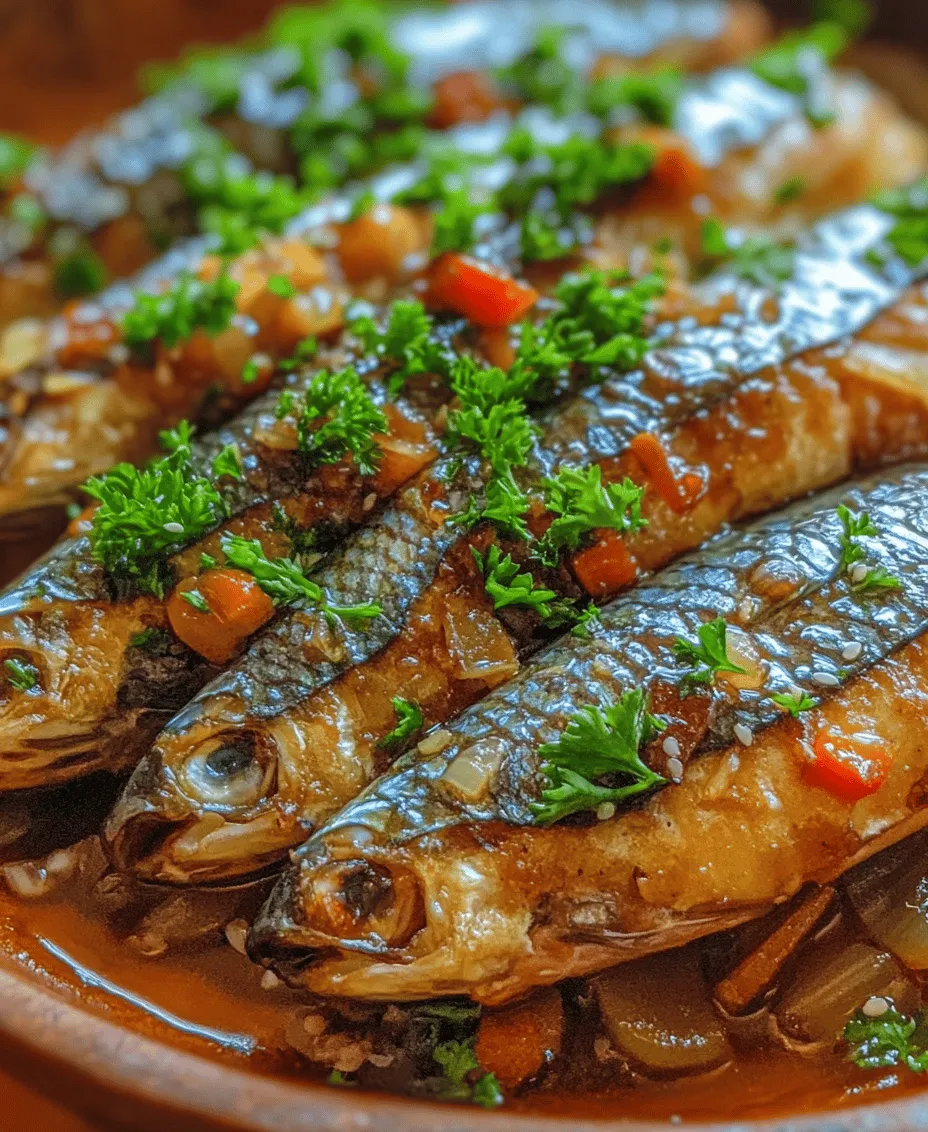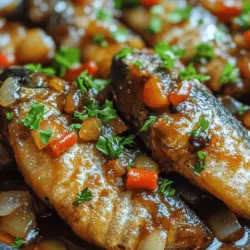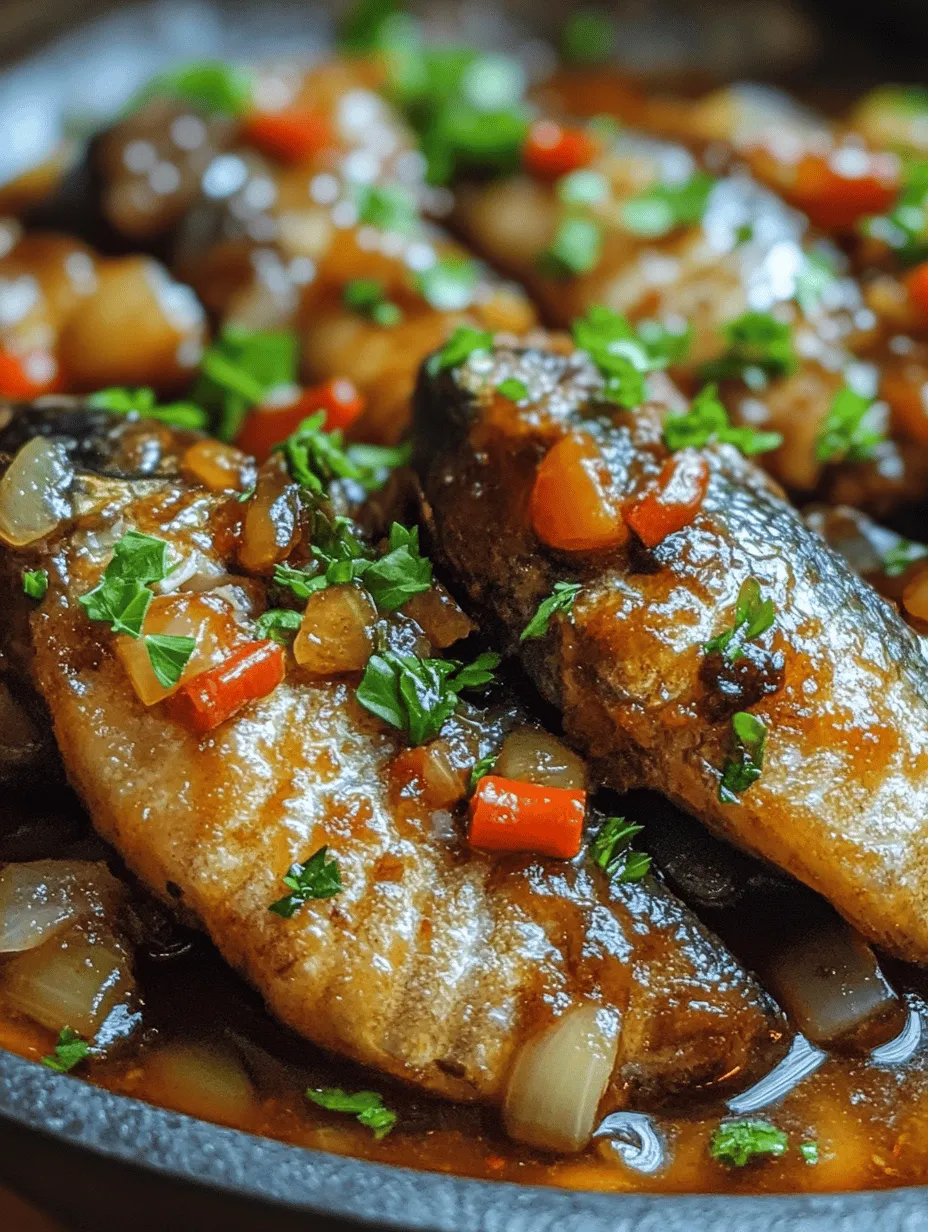Introduction
The bangus, or milkfish, is not just the national fish of the Philippines; it embodies the heart and soul of Filipino cuisine. Known for its delicate flavor and tender texture, bangus has been a staple in Filipino households for generations, celebrated for its versatility in a variety of dishes. From simple grilled preparations to elaborate stews, this fish holds a special place in the culinary landscape of the Philippines. Among its many preparations, one dish stands out for both its rich taste and cultural significance: Bangus Spanish Sardines.
Bangus Spanish Sardines is a delightful home-cooked dish that marries traditional Filipino cooking with modern culinary techniques. This recipe not only showcases the unique attributes of bangus but also transforms it into a flavorful dish reminiscent of the canned sardines popular in many households. With its savory, aromatic sauce and tender fish, Bangus Spanish Sardines appeals to those seeking healthy and delicious meal options, particularly busy households looking to whip up something special without spending hours in the kitchen. In this article, we will explore the unique aspects of this dish, its nutritional benefits, and the detailed steps involved in preparing it from scratch.
Understanding Bangus Spanish Sardines
What sets Bangus Spanish Sardines apart is its ability to capture the essence of traditional sardine recipes while using bangus as the star ingredient. Traditionally, sardines are preserved in a flavorful brine, often infused with spices, herbs, and oil. Bangus Spanish Sardines replicates this process, allowing the fish to absorb the rich flavors of the sauce during cooking, resulting in a dish that’s both satisfying and deeply flavorful.
The origins of Bangus Spanish Sardines can be traced back to the Filipino desire to create a local version of the beloved canned sardines. As canned goods became popular, many Filipino families sought ways to recreate those flavors at home, leading to the evolution of this dish. Over time, variations have emerged, incorporating different spices and techniques, but the fundamental concept remains the same: to celebrate the bangus in a way that resonates with both nostalgia and modernity.
Nutritionally, bangus is a powerhouse. It is rich in omega-3 fatty acids, which promote heart health, and is an excellent source of protein, making it suitable for various diets, including those focused on health and wellness. Additionally, bangus is low in fat and calories, making it a perfect choice for individuals looking to maintain a balanced diet without sacrificing flavor. Whether served over rice, paired with vegetables, or enjoyed as a standalone dish, Bangus Spanish Sardines presents a nourishing option that meets the needs of busy lifestyles.
Ingredients Breakdown
To create the perfect Bangus Spanish Sardines, it’s essential to understand the role of each ingredient in the recipe. Here’s a breakdown of the key components:
1. Bangus (Milkfish): The star of the dish, fresh bangus is preferred for its flavor and texture. When selecting bangus, look for firm, shiny skin and a mild, ocean-like scent. Freshness is crucial, as it dramatically impacts the final dish’s flavor.
2. Onions: Onions are fundamental in building the base flavor of the sauce. Their natural sweetness caramelizes during cooking, adding depth to the overall taste profile.
3. Garlic: Known for its aromatic properties, garlic enhances the dish with a robust flavor. It’s essential to sauté the garlic until golden to bring out its full potential.
4. Chili Peppers: For those who enjoy a bit of heat, chili peppers can be added to taste. They contribute not only spice but also a layer of complexity to the dish.
5. Vinegar: A key ingredient in many Filipino recipes, vinegar adds tanginess and acts as a preservative. It helps balance the richness of the fish and is vital for achieving that signature flavor.
6. Soy Sauce: This ingredient introduces umami, enriching the dish further. For those looking to reduce sodium or avoid soy, alternatives like coconut aminos can be used.
7. Bay Leaves: These leaves infuse the dish with their aromatic qualities, enhancing the overall flavor.
8. Water: Used to create the sauce, the amount can be adjusted depending on how saucy you prefer your dish.
Using fresh ingredients is paramount when preparing Bangus Spanish Sardines. Fresh produce and spices not only enhance the flavor but also improve the dish’s nutritional value. If you’re unable to find fresh bangus, consider using frozen options, but ensure they are thawed properly before cooking.
For those with dietary restrictions, there are several substitutions available. For instance, if you’re looking for a soy sauce alternative, coconut aminos or tamari can provide similar flavors without gluten. Additionally, for a milder flavor, you can use apple cider vinegar instead of the traditional cane vinegar.
Preparation Steps in Detail
Preparing the Bangus
The first step in creating Bangus Spanish Sardines is properly preparing the bangus. Cleaning and filleting the fish can seem daunting, but with a few simple steps, you can master this technique.
1. Cleaning the Fish: Begin by rinsing the bangus under cold running water. Use a knife to scrape off any scales, working from the tail towards the head. Once cleaned, cut off the head and tail of the fish.
2. Filleting the Bangus: Place the fish on a cutting board with the belly facing up. Carefully slide your knife along the backbone, starting from the head and moving towards the tail. Continue slicing until the fillet is completely detached. Repeat this process for the other side of the fish.
3. Removing the Bones: Carefully inspect each fillet for any remaining bones. Using tweezers, gently pull out any small bones to ensure a smooth eating experience.
4. Patting the Fish Dry: After filleting, it’s crucial to pat the fish dry with paper towels. This step is often overlooked, but it is vital for achieving a nice sear when cooking. Moisture can prevent the fish from browning properly and may result in a soggy texture.
Cooking the Base
With the bangus filleted and ready, it’s time to build the flavor base for the dish.
1. Sautéing Onions and Garlic: In a large pan or pot, heat a few tablespoons of oil over medium heat. Add the chopped onions and sauté until translucent, about 3-5 minutes. Next, add minced garlic and sauté until golden brown, taking care not to burn it, as this can impart bitterness to the dish.
– Tip: To enhance the sweetness of the onions, consider adding a pinch of sugar while sautéing.
2. Adding Chili Peppers: If you enjoy a bit of heat, now is the time to add sliced chili peppers. Adjust the quantity based on your spice preference. Sauté the peppers with the onions and garlic for an additional minute to release their flavors.
3. Building the Sauce: Once the aromatics are perfectly sautéed, it’s time to build the sauce. Pour in the vinegar and allow it to simmer for a couple of minutes to cook off the raw acidity. Then, add soy sauce, water, and bay leaves, stirring well to combine the ingredients.
– Tip: Taste the sauce as you go to ensure it meets your flavor preferences. You can adjust the vinegar and soy sauce to achieve the desired balance of tanginess and saltiness.
As you prepare Bangus Spanish Sardines, take a moment to appreciate the cultural significance of each ingredient and the memories they may evoke. This dish not only nourishes the body but also connects families and friends through shared meals and traditions.
In the next part of this article, we will delve deeper into the cooking process, including how to simmer the bangus in the sauce to achieve the perfect tender texture and rich flavors. Stay tuned for more delicious insights as we continue to explore this beloved Filipino dish.

The rich and distinctive flavor of Bangus Spanish Sardines originates from the harmonious blend of soy sauce, vinegar, and a medley of aromatic ingredients. Soy sauce contributes a deep umami essence, while vinegar adds a tangy sharpness that cuts through the richness of the fish. Together, these elements create a complex flavor profile that elevates the dish beyond simple fish preparation. The inclusion of spices such as garlic, peppercorns, and bay leaves enhances the taste, weaving a tapestry of savory and aromatic notes that dance on the palate. This combination not only intensifies the flavor of the Bangus but also reflects the traditional Filipino culinary philosophy of balancing sweet and savory.
In Bangus Spanish Sardines, the sweetness often comes from the natural flavors of the fish itself, which is complemented by the addition of a touch of sugar or even the sweetness of caramelized garlic. This balance between sweet and savory is what makes the dish so appealing, inviting you to savor each bite. The interplay of these flavors is a testament to the art of Filipino cooking, where every ingredient plays a crucial role in creating a well-rounded and satisfying meal.
Simmering the Bangus
To achieve perfectly cooked Bangus Spanish Sardines, proper simmering technique is essential. Start by placing the Bangus in a wide, shallow pan to allow even cooking. Pour the marinade—comprising soy sauce, vinegar, and other ingredients—over the fish, ensuring it is well-coated. A gentle simmer is key; bringing the liquid to a boil can result in tough, overcooked fish. Instead, keep the heat low and let the Bangus cook slowly, allowing it to absorb the flavors of the sauce.
Timing is crucial when cooking fish. Generally, Bangus takes about 15 to 20 minutes to cook through, depending on the thickness of the fillets. You can tell it’s done when the flesh is opaque and flakes easily with a fork. If you have a thermometer, aim for an internal temperature of 145°F (63°C). To enhance flavor absorption, spoon the sauce over the fish occasionally throughout the cooking process. This not only keeps the fish moist but also allows the spices and marinade to penetrate deeply.
Reducing the Sauce
Once the Bangus is cooked, it’s time to focus on the sauce. Reducing the sauce is a critical step that intensifies its flavor and creates a glossy finish. To achieve the right consistency, remove the Bangus from the pan once it’s cooked and set it aside. Increase the heat to medium-high and let the sauce simmer uncovered. Stir occasionally to prevent sticking and to monitor the reduction. The goal is to reduce the sauce until it thickens slightly, which should take about 5 to 10 minutes.
A well-reduced sauce not only enhances the dish’s presentation but also heightens its taste. A thicker sauce clings beautifully to the fish and creates a visually appealing glaze, making the dish more enticing. The final result should be a rich, dark sauce that complements the Bangus while adding depth and character to every bite.
Serving Suggestions
Bangus Spanish Sardines is best served with steaming white rice, which perfectly absorbs the flavorful sauce. Accompanying the dish with pickled vegetables, such as atchara (pickled green papaya), adds a refreshing crunch and balances the savory richness of the fish. A sprinkle of chopped green onions or crispy fried garlic on top provides an additional layer of flavor and texture, enhancing the dish’s overall appeal.
Presentation plays a significant role in enjoying this dish. Serve the Bangus in a large, shallow serving platter, drizzled generously with the thickened sauce. Arrange the pickled vegetables alongside the fish, creating a vibrant contrast of colors. In Filipino households, Bangus Spanish Sardines often takes center stage at the dining table, embodying the spirit of sharing and togetherness. This dish is not just a meal; it’s a celebration of family, culture, and tradition.
Variations and Adaptations
One of the great aspects of Bangus Spanish Sardines is its versatility. You can easily customize the recipe to suit personal tastes or dietary restrictions. For instance, if you’re looking to reduce sodium, consider low-sodium soy sauce or coconut aminos as a substitute. For those seeking a kick of heat, adding chili peppers or a dash of hot sauce can elevate the flavor profile.
If you have leftovers, the possibilities are endless. Bangus Spanish Sardines can be flaked into salads, mixed into pasta dishes, or used as a filling for sandwiches or wraps. The savory flavor of the fish can transform a simple dish into something extraordinary. Additionally, seasonal variations can be incorporated by adding fresh vegetables such as bell peppers, tomatoes, or even leafy greens during the cooking process, allowing you to enjoy the dish while taking advantage of what’s fresh and available.
Conclusion
Cooking Bangus Spanish Sardines at home is not just about the recipe; it’s about embracing the flavors and cultural heritage of Filipino cuisine. The process of simmering the fish, reducing the sauce, and presenting it beautifully is an experience that brings joy and satisfaction. Each time you prepare this dish, you connect with a rich culinary tradition that has been passed down through generations.
As you gather around the table with family and friends, the act of sharing meals becomes a meaningful ritual. Bangus Spanish Sardines serves as a reminder of the importance of connection and community, inviting everyone to partake in the delicious flavors of Filipino culture. So, gather your loved ones, prepare this delightful dish, and enjoy the incredible experience of savoring a meal that not only fills the stomach but also nourishes the soul.



